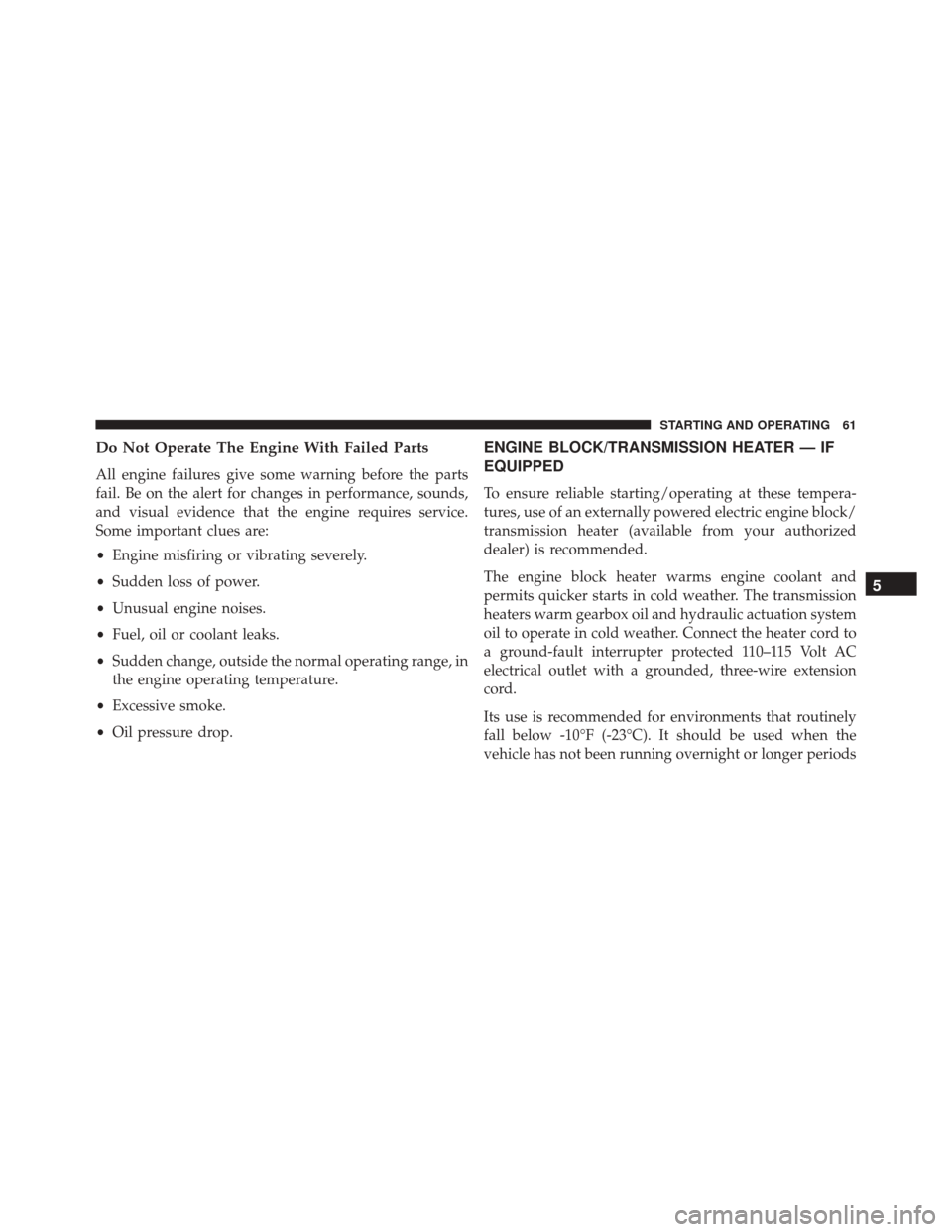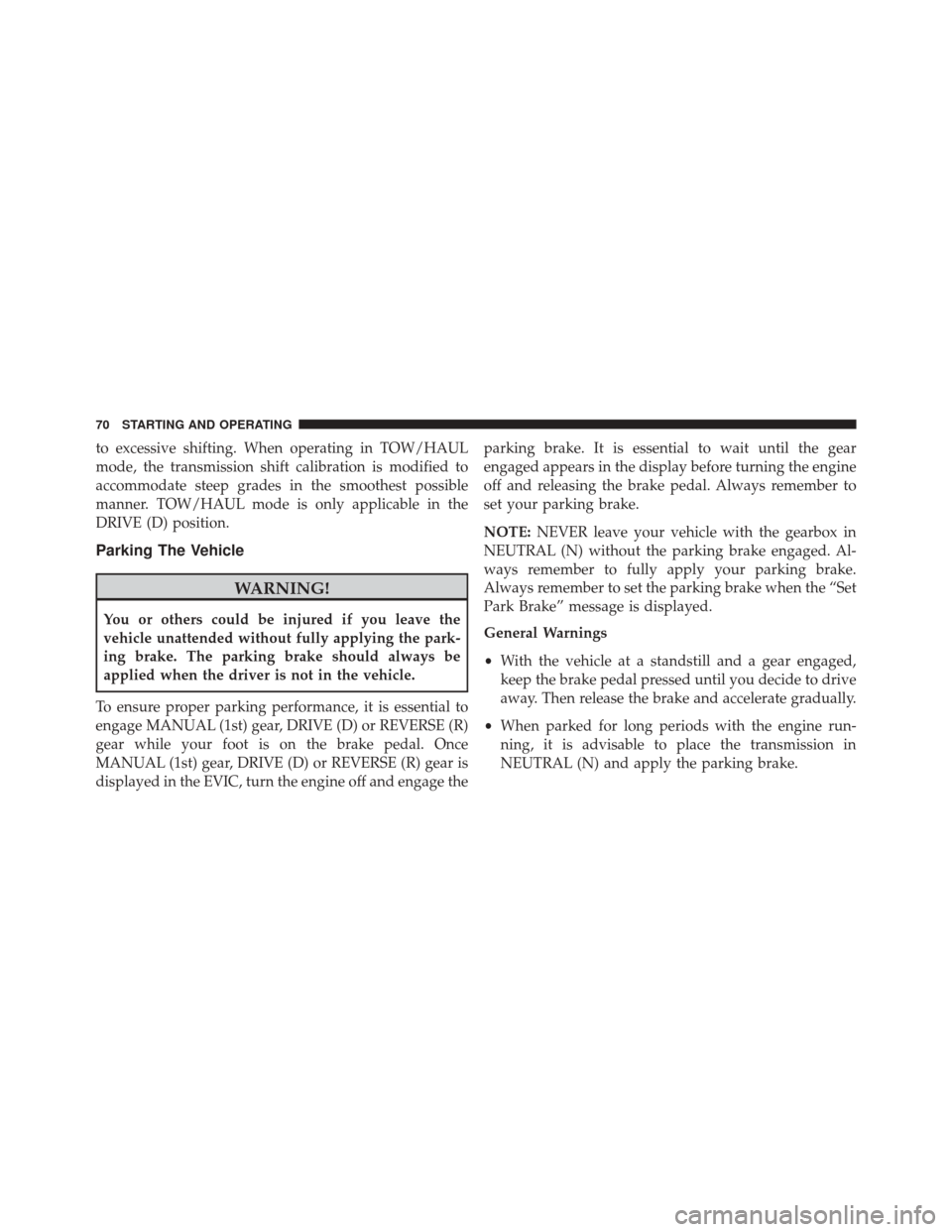Page 63 of 145

Do Not Operate The Engine With Failed Parts
All engine failures give some warning before the parts
fail. Be on the alert for changes in performance, sounds,
and visual evidence that the engine requires service.
Some important clues are:
•Engine misfiring or vibrating severely.
• Sudden loss of power.
• Unusual engine noises.
• Fuel, oil or coolant leaks.
• Sudden change, outside the normal operating range, in
the engine operating temperature.
• Excessive smoke.
• Oil pressure drop.
ENGINE BLOCK/TRANSMISSION HEATER — IF
EQUIPPED
To ensure reliable starting/operating at these tempera-
tures, use of an externally powered electric engine block/
transmission heater (available from your authorized
dealer) is recommended.
The engine block heater warms engine coolant and
permits quicker starts in cold weather. The transmission
heaters warm gearbox oil and hydraulic actuation system
oil to operate in cold weather. Connect the heater cord to
a ground-fault interrupter protected 110–115 Volt AC
electrical outlet with a grounded, three-wire extension
cord.
Its use is recommended for environments that routinely
fall below -10°F (-23°C). It should be used when the
vehicle has not been running overnight or longer periods
5
STARTING AND OPERATING 61
Page 72 of 145

to excessive shifting. When operating in TOW/HAUL
mode, the transmission shift calibration is modified to
accommodate steep grades in the smoothest possible
manner. TOW/HAUL mode is only applicable in the
DRIVE (D) position.
Parking The Vehicle
WARNING!
You or others could be injured if you leave the
vehicle unattended without fully applying the park-
ing brake. The parking brake should always be
applied when the driver is not in the vehicle.
To ensure proper parking performance, it is essential to
engage MANUAL (1st) gear, DRIVE (D) or REVERSE (R)
gear while your foot is on the brake pedal. Once
MANUAL (1st) gear, DRIVE (D) or REVERSE (R) gear is
displayed in the EVIC, turn the engine off and engage the parking brake. It is essential to wait until the gear
engaged appears in the display before turning the engine
off and releasing the brake pedal. Always remember to
set your parking brake.
NOTE:
NEVER leave your vehicle with the gearbox in
NEUTRAL (N) without the parking brake engaged. Al-
ways remember to fully apply your parking brake.
Always remember to set the parking brake when the “Set
Park Brake” message is displayed.
General Warnings
• With the vehicle at a standstill and a gear engaged,
keep the brake pedal pressed until you decide to drive
away. Then release the brake and accelerate gradually.
• When parked for long periods with the engine run-
ning, it is advisable to place the transmission in
NEUTRAL (N) and apply the parking brake.
70 STARTING AND OPERATING
Page 73 of 145

•To avoid accelerated clutch wear, do not use the
accelerator to keep the vehicle at a standstill (for
example, holding on a hill); the clutch could be dam-
aged by overheating. Use the brake pedal instead and
operate the accelerator only when you are ready to
drive away.
• Only launch (from a stop) in second gear when you
need more control on surfaces with low traction.
• Only shift between DRIVE (D) and REVERSE (R) gears
when the vehicle has come to a stop and the brake
pedal is pressed. •
Although very inadvisable, if the vehicle is unexpect-
edly allowed to roll downhill with the gearbox in
NEUTRAL (N) the system will automatically engage
the gear best suited to vehicle speed when a gear shift
is requested to allow drive to be correctly transmitted
to the wheels.
• If necessary, with the engine off, it is possible to engage
1st, REVERSE (R) or NEUTRAL (N) with the key in
ON/RUN/MAR position and the brake pressed.
• During hill starts, accelerate immediately after releas-
ing the parking brake or brake pedal to allow the
engine to increase its rpm to a greater extent and
overcome higher gradients with more torque.
5
STARTING AND OPERATING 71
Page 125 of 145
Chassis
ComponentFluid, Lubricant, or Genuine Part
Automated Manual Transmission
• Gearbox: Full synthetic 75W-85 manual transmis-
sion fluid meeting the API GL4 specification.
• Control system: MOPAR C Series DDCT SAE 75W
Hydraulic Fluid or equivalent.
• Hydraulic Clutch Operating System: MOPAR
Brake and Clutch Fluid DOT 4 Motor Vehicle or
equivalent.
Failure to use the correct fluid may affect the function or
performance of your transmission.
Brake Master Cylinder We recommend you use MOPAR DOT 4.
Power Steering Reservoir Use Pentosin CHF 11S power steering fluid meeting
FCA US Material Standard MS-11655.
6
MAINTAINING YOUR VEHICLE 123